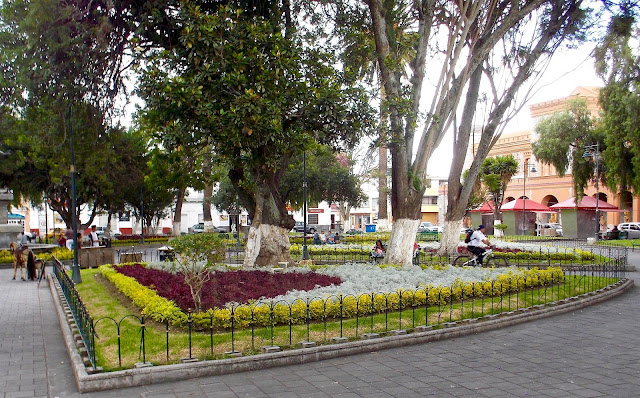Buses in Ecuador are as brightly-coloured as the shawls we were about to see in the market.
The journey took us through countryside that was not as spectacular as we'd seen in Peru, but nevertheless dramatic: bare mountainsides cut by deep ravines.
We had booked a hotel on the hillside just above town, giving us an overview of the locale, and a glimpse of the cloud-wreathed volcano across the valley.
The market occupied all of the main square. I took this photo from a bar where you could enjoy a mojito while you watched the action.
There were all kinds of alpaca sweaters, bags and hats,
... necklaces
... embroidered blouses
... and, the most colourful of all, gorgeous woven shawls.
If I'd had an extra suitcase, I'd have filled it with these.
By comparison with their wares, most of the vendors were soberly dressed in black and white.
We spent much of the afternoon just wandering around, enjoying the scenery, but as we sauntered back towards our hotel we encountered a parade that appeared to be celebrating either the winning of a trophy or the start of a game to decide the winner.
The following day, we boarded a bus to Ibarra, the regional capital an hour further north, to see the colonial architecture that has caused it to be known as "the white city."
Not all of the buildings were white; some were natural brick, both old ...
...and new.
Most of the shops were shut and the town seemed deserted on this hot Sunday afternoon, but we found a cafe serving icecream and took our cones to a shady seat in the pretty central park with its neat parterres and flowering trees.
Monday was our last day in Ecuador, but as our plane didn't leave until midnight we had most of another day to enjoy Otavalo. We had hoped to visit a nearby condor refuge but discovered it was closed. Instead we took a taxi to Peguche waterfall, not far from the town. A taxi dropped us in a small cluster of shops at the start of a short trail where the main item on sale seemed to be mosquito repellent of various kinds. Fortunately, we didn't encounter more than one or two during our visit.
Along the trail we came across an ancient tree that obviously had some local significance. The sign identifies it as Arbor de la Fertilidad, Fertility Tree
There had been some significant rain and the waterfall was impressive.
A number of local people had come to see it too, including a group of youths who were clambering over the rocks at its base. One of them slipped and managed to soak himself completely in the chilly water.
We decided to walk back to town, which gave me a chance to see close-up a plant I'd noticed growing wild in numerous places along to road all the way from Quito. Lion's ear (Leonotis leonurus) is an annual or occasionally a short-lived perennial in Vancouver, and it was interesting to see it growing so freely that I assumed it must be native to South America. However, it's South African.
Back in Otavalo, we sat for a while in a coffee shop on the edge of the market as a sudden rainstorm descended on the town. Across the road a street musician had taken shelter under a convenient stall awning and whiled away the time serenading the owner. He moved on when the awning suddenly tipped a deluge of water onto them both.
When the rain stopped, we spent some time exploring parts of the town we hadn't seen before. In an area around the government offices, we noticed some lovely stained glass work attached to the lamp posts. We even went back later to see how they looked at night, but the lamps were too dim to illuminate them as well as the evening sun had done.
After that it was time to catch our bus back to Quito and the airport. Through the tinted window I took a last shot of another of the several volcanoes ringing the valley.





























